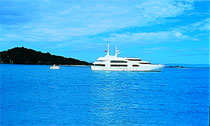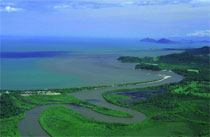|
Unit on 'The Great Barrier Reef and its Coastal Zones'
From Angela Coliver, Education, The Great Barrier Reef Marine Park Authority
In this unit, students investigate the Great Barrier Reef and its coastal zone as natural systems, and as places visited and used by people.
An investigation of, or field trip, to the Great Barrier Reef or a local coastal area forms the centre of this unit.
The inquiry approach is built around the need to prepare for the investigation or the fieldwork, broaden student experiences and understandings during the investigation or the field trip, and consolidate and extend them following the study or visit.
Teachers will be able to select and adapt activities to suit student needs and the type of coastal or marine environment investigated. These activities look at natural systems, human use and modification of the Great Barrier reef and its coast, dangers and safety issues, pollution and care of the Great Barrier Reef and its coastal area.
The Great Barrier Reef consists of the worlds largest system of coral reefs, mangrove and esturarine communities. It is part of a sensitive ecosystem, which includes mangrove and estuarine communities. All are part of an important natural system in our environment. People value the Great Barrier Reef and its coastal zone as an important natural system and as a place they use.
Many people use the Great Barrier Reef and its coast for recreational and commercial activities. What happens upstream in the catchment affects the Great Barrier Reef and its coastal areas. An awareness of safety issues is important to people's enjoyment and use of marine and coastal areas. |
 |
- Why do people go to the Great Barrier Reef and coastal areas?
- What would you expect to find at the Great Barrier Reef and other coastal areas?
- How can we care for and value the Great Barrier Reef and coastal areas?
- What are the dangers facing these areas?
- How are the Great Barrier Reef and its coastal areas changing?
Beach, beachcombing, biodiversity, birds, bleaching, boardwalk, boats, breakwater, care, carnivore, catchment, cliffs, coast, coastal, conserve, contaminate, corals, crabs, danger, diving, environment, erosion, estuary, fish, fishing, food web, fragile, future, habitat, herbivore, jellyfish, litter, manage, mangroves, marine, mussels, nutrients, omnivore, organisms, pebbles, pollution, predator, reef, recycle, restore, rock pools, rocks, salt, sand, sand dunes, sailing, samphires, sea, seagrass, seabirds, seaweed, sediments, sensitive, shells, shore, snorkelling, solutions, stormwater, sun, sunscreen, swim, swimming, system, tides, value, vegetation, walking, wastewater, water, waves.
|
Studies of Society and Environment (SOSE); Science; Health and Physical Education; and English.
Collecting, analysing and organising information; Communicating ideas and information; Planning and organising activities; Working with others in teams; and Using mathematical ideas and techniques.
|
 |
|